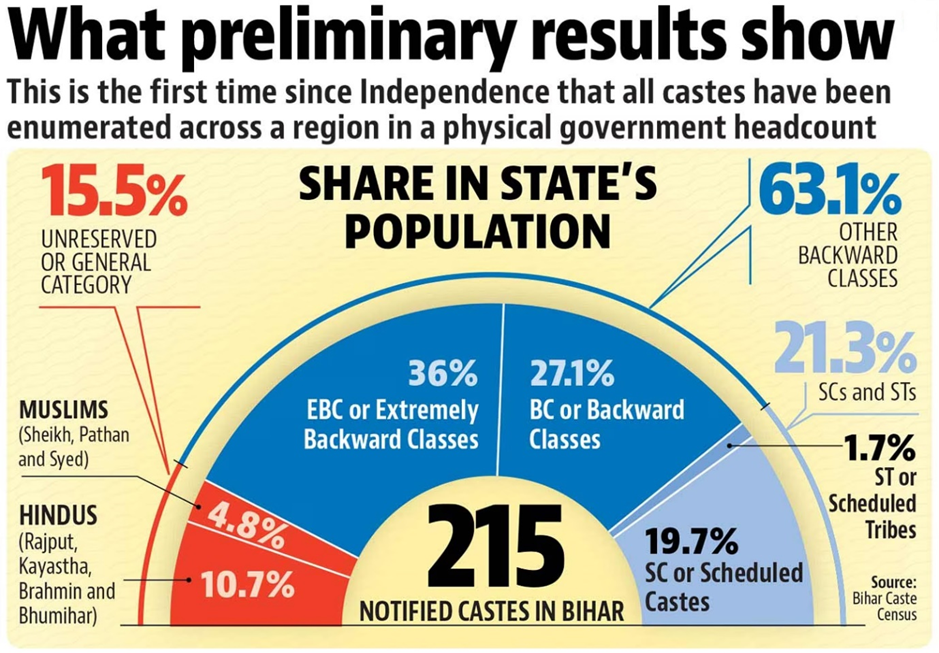POLITICS OF POSITIVE DISCRIMINATION FOR THE IDEA OF INDIA
Relevance: GS 2 – Welfare schemes for vulnerable sections of the population by the Centre and States and the performance of these schemes
Why in the News?
- The Bihar caste census of 2023 has the potential to alter the political dynamics between communities and parties ahead of the upcoming state elections.
- It has brought to light certain faultlines within the social fabric of the state.
- The findings of the census may influence the strategies and alliances of political parties vying for power in Bihar.
- The revelations from the census could lead to shifts in voter behavior and party support based on caste affiliations.
State Cabinet Decisions
- The state cabinet of Bihar took a significant decision to increase caste-based reservations from 50 percent to 65 percent.
- Additionally, they introduced a further 10 percent reservation for economically weaker sections.
- These decisions aimed to address historical injustices and promote development with equity through affirmative action.
National Implications
- The implementation of enhanced reservations in Bihar served as a catalyst for the formation of the “INDIA bloc,” particularly championed by the Congress party.
- This issue transcended regional boundaries and was adopted as a national agenda, reflecting a broader concern for social justice and equity across the country.
Alignment with Constitutional Principles
- The initiatives undertaken in Bihar align with the principles enshrined in the Preamble to the Constitution of India.
- The Preamble embodies the ideals and aspirations of the nation, emphasizing liberty, equality, and fraternity.
- These initiatives reflect India’s commitment to realizing these constitutional values through democratic processes, institutions, and policies designed to rectify historical injustices and promote inclusive development.
Utilization of Historical Data
- The caste census of 1931 served as a crucial reference point for understanding the socio-economic landscape, particularly in the absence of contemporary data until the Bihar census.
- This historical data facilitated the formulation of policies aimed at uplifting marginalized communities and promoting inclusive development.
Initiatives for Positive Discrimination
- Various initiatives, including reservations for Scheduled Castes (SC), Scheduled Tribes (ST), and Other Backward Classes (OBC), were undertaken to address historical injustices and bring marginalized groups into the mainstream of development.
- The categorization of OBCs into creamy and non-creamy layers, as well as the identification of extremely backward classes (EBC), were based on extrapolations from available data.
- Importance of Updated Data:
- There is a pressing need for fresh data on the distribution and structure of castes in India to inform policy decisions accurately.
- The Bihar caste survey provided updated and comprehensive data for the state, encompassing a wide range of caste configurations even after the Rohini Commission, including 215 sub-castes.
- This data facilitated informed decision-making, particularly in the context of implementing positive discrimination measures aimed at delivering development with justice and inclusivity.
Key Findings of the Survey ordered by Supreme Court
- The survey included essential caste-based indicators such as residential status, occupational structure, employment, monthly income, educational status, and migration, along with counting citizens by 215 caste categories.
- Backward Classes (BCs) and Extremely Backward Classes (EBCs) constitute 13 percent and 36.01 percent, respectively, in Bihar.
- Among BCs, Yadavs emerged with the highest population share at 27 percent, followed by Kushwaha, Kurmi, and Bania.
- Among EBCs, Telis emerged with the highest share at 81 percent, followed by Mallah.
- Among Scheduled Castes (SCs), Dusadh, Dhari, and Dharhi have the largest presence in the state with 5.31 percent, followed by Chamar, Mochi, Rabidas, Rohidas, Charmakar, with 5.26 percent, and Musahar with 3.09 percent.
Impact of Caste Survey on Muslim Representation
- Muslims, constituting 71 percent of the population, have been delineated into non-general and general caste categories after the survey.
- Non-general caste Muslims now comprise 92 percent, while general-caste Muslims constitute only 4.79 percent.
- This division may empower Pasmanda Muslims, aligning them with the politics of Backward Classes (BCs) and Extremely Backward Classes (EBCs), potentially diluting political polarization based on religion.
Socioeconomic Insights from the Survey
- The survey highlights the caste-wise disparities in living conditions, with BCs, EBCs, and SCs facing high incidences of poverty, low education, and poor residential conditions.
- Despite infrastructure growth under previous governments, these marginalized communities continue to face challenges.
- The caste survey has not only provided insights into the demographic landscape of Bihar but also has far-reaching implications for politics, social dynamics, and policymaking in the state and beyond.
Mains question
Analyse the impact of the Bihar caste census on socioeconomic dynamics and government policies in the state, with a focus on marginalized communities. (250 words)




